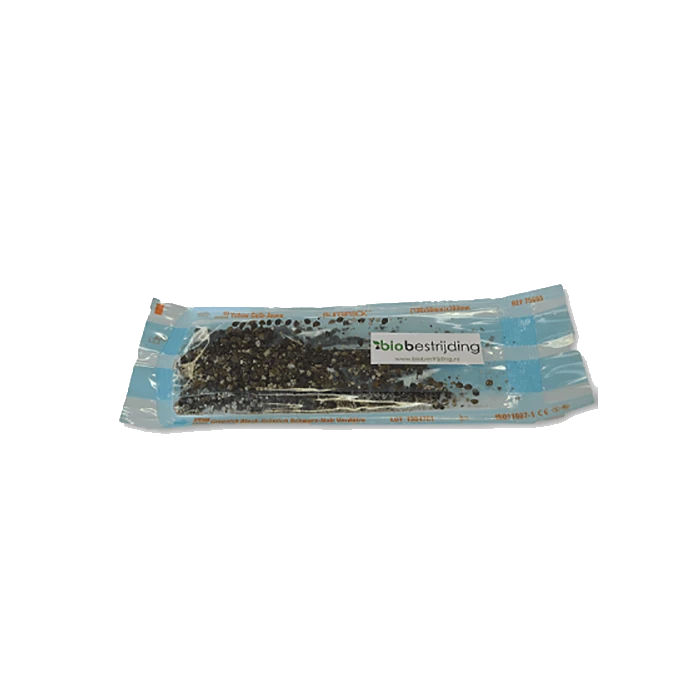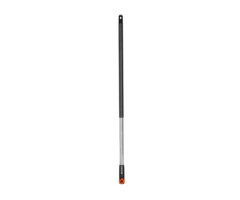BioBestrijding | Predatory Mite against Blood Lice ~ Hypoaspis miles
BioBestrijding Predatory Mite against Blood Lice
Attention! This product consists of live animals and is only available for order in the Netherlands or Belgium. If you order more than just Bio Fight, there will be an additional charge of € 7.95 due to dropshipping from the supplier.
Predatory mite the Hypoaspis miles (also known under other names such as Stratiolaelaps scimitus) is a 100% biological control of blood lice. The predatory mite seeks out the blood lice in the smallest of nooks and crannies and is a fierce fighter of blood lice and almost always comes out on top.
What is Hypoaspis miles?
The Hypoaspis miles is a soil predatory mite also known as Stratiolaelaps scimitus. This predatory mite targets a wide range of insects and is widely used in horticulture but is also useful as a natural enemy of the blood mite (blood louse). The Hypoaspis miles is a light brown-beige predatory mite and about 0.8 - 1 mm in size, the predatory mite is in all stages of its life about the same in appearance. This predatory mite occurs naturally in large parts of Europe and is a soil predator. This means that it lives in the top layer of soil up to 4 cm deep and can move quickly through and across the soil.
This predatory mite feels at home in moist (potting) soil, the humidity is therefore important for proper development and control. The Hypoaspis thrives best with a humidity of sun 70% and prefer high temperatures of 20 to 30 degrees. Under these conditions the predatory mite will multiply and fight the blood lice best. An adult Hypoaspis predatory mite lives for about 6 weeks and is active at temperatures of 10 to 30 degrees. At higher or lower temperatures, this predatory mite will be less active or go into rest. A population of this predatory mite consists of both males and females. If there is enough to eat the females lay eggs frequently, the eggs are oval shaped. The eggs hatch within 2-3 days and the young Hypoaspis nymphs are born. The nymphs develop into an adult predatory mite in about 5 to 6 days. Immediately after birth, the young nymphs are fierce predators that consume eggs and small larvae of the blood louse. An adult Hypoaspis can consume up to 5 prey per day.
Amount of predatory mites needed
The quantity required depends on the size of the house and the number of animals, in general we recommend 150 predatory mites per animal. The predatory mites are delivered in bags containing litter (a type of potting soil) containing eggs, young and adult specimens of the predatory mite. The blood louse reproduces extremely fast in summer. In warm weather, blood lice that are present can reproduce 10 to 100 times in 1-2 weeks. After the heat wave, the infestation can be controlled, but the damage of the infestation cannot be undone afterwards. Preventing sun infestation is better. Preventive use of predatory mites can prevent a blood aphid infestation. It is important to introduce predatory mites early in the spring. This keeps the infection pressure as low as possible. Stratiolaelaps scimitus preferably eats the larvae and nymphs of the aphids and prevents reproduction of the remaining aphids.
Keep an eye on the activity of the predatory mites after a few weeks, weekly inspection of the predatory mites is recommended. You can inspect the activity of the predatory mites as follows: take some soil from the closet and place it on a white sheet/paper. Look at the material with a magnifying glass to see if there are still living predatory mites. If you can still find predatory mites then it is sufficient. It is possible that the predatory mites die out because there is not enough food or due to unfavourable weather conditions. If no predatory mites can be found we recommend reintroducing predatory mites provided the temperature allows it. The first result you will notice after about two weeks but complete eradication of the blood mite is very difficult. After about two weeks you may notice that the blood mites are restless and it even seems that there is an increase of blood mites, this is a sign that the predatory mites have chased the blood mites out of their hiding places and therefore the predatory mites are doing their job well.
Release of predatory mites
For good control it is important to create a pleasant place for the predatory mites. If the predatory mites have a habitat where they can live, the control will follow naturally. Introducing the predatory mites is simple. The substrate should be evenly distributed in the loft or house in the places where the blood lice stay during the day, for example: the seats of the birds, in nesting places, in places where the manure falls, at the bottom of feed troughs or gutters, but also near cracks and fissures in the walls. The predatory mites actively seek out the blood lice.
The predatory mite proceeds as follows, it approaches the blood louse and stings it with its snout. The predatory mite administers poison to the blood louse, which kills the blood louse. It may take some time before you notice the first result. A total destruction of the blood louse is very difficult to achieve, especially if there is already a large amount of blood lice it is difficult to control it in total. However, it is an environmentally friendly treatment and it certainly has results. The effect of the treatment is usually visible after two to three weeks. After about two weeks you may notice that the blood lice become restless and it seems that there is even an increase, this is a sign that the predatory mites have chased the lice out of their hiding places and that the predatory mites are doing their job well. After an effective control the animals are less restless, the blood loss is reduced and caretakers of the animals will not be irritated by the blood lice anymore.
Start early with release
It is ideal to get the loft free of blood lice in the spring so that you can start with a clean slate. It is important to introduce predatory mites early in the season so that the eggs and larvae are dealt with. Predatory mites work very well against blood lice as long as the population is not so large. If there is a huge infestation of blood lice it will be very difficult for the predatory mites to combat them. The aphids reproduce so rapidly that the predatory mites are always behind the facts. The number of predatory mites must therefore be sufficient (in proportion) and they should be deployed early.
The disadvantage of the predatory mites is that they, like the blood louse, do not like cold temperatures. The predatory mite is also only active at about 12 degrees. Our advice is to release the predatory mites in large numbers in spring as soon as the temperature is around 12-15 degrees. Then you are early and you can put a brake on the growth of blood lice. If there is already an infection of blood lice you should release the predatory mites as soon as possible to limit further growth of the infection. It is very difficult to eradicate blood lice completely, but the predatory mite is a very good natural enemy to limit the damage.
Disinfect the hen-house for effective control
Empty the entire coop, remove all litter and hay Disinfect the coop with a disinfectant, treat the coop with steam or water of at least 70 degrees or use a paint strip hair dryer to burn out the seams and cracks (remember fire hazard!). During the day, the blood lice and eggs are found mostly in the seams, cracks and crevices of the coop. Give these places extra attention when disinfecting.
Our advice is to seal these seams, after disinfecting, as much as possible with a silicone sealant. The fewer gaps and cracks there are the better. Also think about the perches on which the chickens sit and clean them with, for example, thin chlorine. A tip is to make the perches floating (e.g. with wires on the ceiling) so that the blood louse cannot crawl into the perch. Fill the cage with new straw, sawdust or hay. Repeat this procedure if necessary, especially in warm weather clean the cage more often. Good hygiene has a preventive effect against blood lice. Do not turn off the predatory mites immediately after cleaning, even the predatory mites do not like chlorine or other cleaning agents.
User instructions
Upon receipt of your order, the predatory mites should be released as soon as possible. Turn/shake the bag slightly before use. Open the bag of predatory mites by cutting a corner of the bag. The substrate should be spread evenly in the pen or house in the places where the blood lice stay during the day, for example: the seats of the animals, in nesting places, in places where the manure falls, at the bottom of feeding troughs or gutters, but also near cracks and crevices in walls.
During spreading you can see through the transparent part how many predatory mites are left in the bag. This allows you to carefully and dosed release of predatory mites. The substrate should not be spread in the manure, because the predatory mites do not survive if they are covered with too much manure. They only survive in the top 2 cm of the manure. Removal of manure during the first 2-3 days after releasing the predatory mites should be avoided as the predatory mites need several weeks to adapt to the house environment.
How often you should introduce the predatory mites depends on several factors, including the duration and intensity of the infestation pressure. The predatory mites feel at home in slightly moist soil, it is advised to keep the soil moist by spraying it regularly. Make sure the soil is not too wet! The Hypoaspis predatory mites are active from 10 degrees but only come into action at a soil temperature of 15 degrees. The optimum temperature is between 20 and 30 degrees. 26 degrees is the most ideal for the development.
Storage advice
Biological control agents are living animals and have a (very) short life span and should therefore be introduced into the crop as soon as possible after receipt. Storage can negatively influence the quality and is only possible under the conditions mentioned below.
- Storage life: 1-2 days
- Storage temperature: 8-10C
- Store in the dark and flat
Please note! If you order more than just BioBestrijding, there will be € 7.95 extra charge because of the dropshipping from the supplier.




